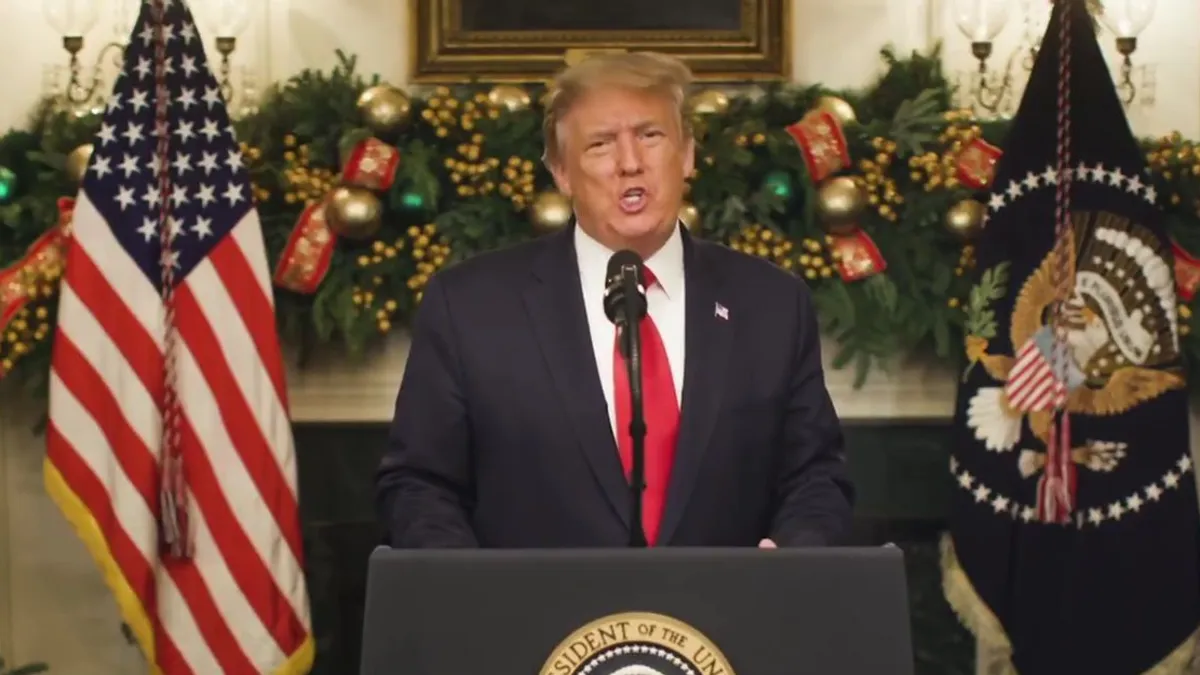UPDATE: December 28, 2020: President Donald Trump late Sunday reversed course and signed the second round of stimulus, although he continued to insist that payments to consumers be raised to $2,000 and that some items be removed from the spending bill. As Trump noted in his statement, the House of Representatives is scheduled to vote on that increase Monday. Given the waning days of the Congressional session, however, neither that nor the other changes are likely to be made. The nearly one-week holdup in signing the bill will mean that any additional unemployment or other relief will also be delayed.
Dive Brief:
-
In a tweeted video Tuesday night, President Donald Trump imperiled a $900 billion COVID relief package passed by Congress this week, demanding its $600 payments to consumers be raised to $2,000, calling for more aid to small businesses and insisting some provisions be deleted, although those were part of a larger spending package unrelated to the pandemic.
-
While he didn't outright threaten to veto the bill, his remarks left the impression that he might, or let it languish without his signature. A bill can become law without a presidential signature within 10 days, excluding Sundays, but can't if Congress is adjourned during that time, as it will be in coming days.
-
U.S. House Speaker Nancy Pelosi swiftly tweeted back "Let's do it!" But renegotiating the bill is uncertain given the months it took to agree on it. The bill passed with a veto-proof majority in both houses, but would have to be voted on again to become law, and only after the president actually vetoes it.
Dive Insight:
The COVID package that Congress is delivering to Trump's desk this week never had the potential to support consumers and businesses or stimulate the economy the way the first one did. For his part, the president called it a "disgrace."
Certainly it's more modest than the support passed and signed into law this spring, which came to some $3 trillion. Despite it, the economy shed nearly 10 million jobs since February and many businesses, including many retailers, watched their revenue plummet.
The direct payments in the new bill are around half the amount sent out in the spring. The new support also includes $300 in added weekly unemployment assistance; $13 billion in added food and child nutrition benefits; and more than $284 billion for forgivable paycheck protection loans for businesses, according to a summary of the bill released Sunday by House Speaker Nancy Pelosi (D-CA).
Trump's video remarks ran counter to what had generally been considered his tacit endorsement of the new package, considering that his Treasury Secretary, Steven Mnuchin, worked on it with Congressional leaders. Many economists see it as crucial in getting the U.S. economy safely into the first quarter without a deeper recession. Wells Fargo economists in emailed comments Tuesday called it "an income bridge for cash-strapped consumers and businesses heading into an otherwise bleak winter."
"We doubt this package will be enough to fully offset the economic damage that has already been done and is still to come, but it should go a long way toward smoothing over what could be a challenging next few months for the U.S. economy," Wells Fargo Senior Economist Tim Quinlan said.
Before this bill became endangered, the retail industry advocated for yet more relief in the new year. The Retail Industry Leaders Association in an email on Monday called the latest package "an important first step," while the National Retail Federation on Tuesday called it "a down payment on economic relief next year."
"The November retail sales report shows that consumers held back on spending, and more robust stimulus is needed to shore up our economy," the NRF also said in its statement. "These are trying times for many American families, and a strong stimulus bill is critical to the continued recovery of the economy and the retail industry, which creates employment for 52 million working Americans."














